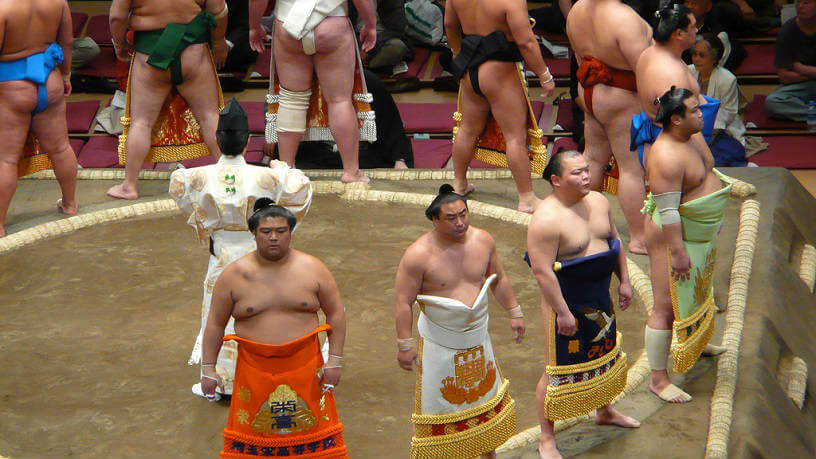Experience Traditional Sumo Wrestling in Tokyo

When you try to conjure up images of Japanese culture, few pictures will rank as highly as Traditional Japanese Sumo Wrestling. The age-old wrestling match between scantily clad, heavyweight men is not only an icon of Japanese culture envisioned by foreigners, but it is also Japan’s national sport and it rightfully deserves its important status.
Originating in ancient times, Sumo wrestling was initially a way to entertain Shinto deities and it was used as a trial of strength in combat. This important ritual for the imperial court, required a representative from each province to attend the contest and fight.
Take a Look
Say you find that Sumo matches catch your interest and you’ve got plans to visit Tokyo. Unsurprisingly, you’ll probably want to sneak in a traditional match. Unfortunately, sneaking it in is not always easy. The best way to view a professional match is to go to the tournament. The tournament is only held in Tokyo three times a year: January, May, and September. If you find that you simply cannot visit during one of these tournaments, try visiting an exhibition tournament or if you have an ample amount of patience you can catch a morning practice session at a sumo stable. The sumo stables are quite strict and insist the visitor is with someone that speaks fluent Japanese. You are also not permitted to disturb the practice in any way and often must sit still, and stay absolutely quiet for 2 or 3 hours.
Tournament
At the Sumo tournaments, you can catch a match starting early in the morning. If, however, you want to enjoy the pulsing excitement that comes from watching the sport while surrounded by crowds of avid fans and spectators, try to visit later in the day.
There are three types of seats for you to take in the matches: Ringside, Box Seats, and Balcony Seats. The ringside seats are very expensive and difficult to get, but they are the most coveted. Be wary though, as the seats may be exciting, you have to watch out for toppling sumo wrestlers that can come flying toward you at any time. The Box Seats are spread out amongst the rest of the stadium’s first floor in traditional Japanese style. Shoes are removed and you will be seated on cushions. Balcony seats are on the second floor and are laid out in Western-style seating. There are also a number of balcony seats for same-day ticket holders, the cheapest type you can get.
Once you find your seat, pick a favorite wrestler and see how he fares. Each wrestler adheres to the ranking hierarchy which is updated after each match.
Sumo Extras
Maybe you can’t visit the tournament or maybe you want to experience and appreciate as much of the Sumo culture as you can. There a number of other ways to enjoy the sport. For one alternative option, head to Tokyo’s Ryogoku district. This district has been the center of the sumo world for over two centuries and is home to plenty of experienced wrestlers and their fans, coaches and more.
Sumo Museum
Located inside the stadium, this small museum houses exhibitions about the sport, a collection of portraits featuring past and present significant sumo events.
Ekoin Temple
A nod to the lively past of sumo wrestling, this temple was once the home of the tournaments before the stadium was built. Now, you can view the stone monument erected in honour of past and present wrestlers and stroll around the area.
Chanko Nabe Restaurant
You will find many Chanko Nabe restaurants in the Ryogoku district, as Chanko Nabe is the staple food of sumo wrestlers. Many of the restaurants are owned and operated by retired wrestlers and many of the restaurants even have dohyo rings in them. Try out the sumo staple for yourself and maybe even snap a picture in the ring.
For your holiday in Tokyo, depend on Cover-More Australia for your travel insurance needs and coverage options.
Image courtesy of Flickr user heschong.
Planning a trip?
Discover Our COVID-19 Cover
To find out what our current* benefits do – and don’t – cover, please read:
Plus, for helpful destination-based COVID-19 information, don't forget to check the COVID-19 Travel Risk Tool before and during travel.
*The cover information contained on the above pages refers to Cover-More policies sold on or after 26 June 2023. For cover information on policies sold prior to this date, please read the relevant PDS.